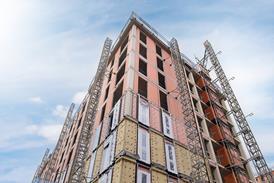Well, the surveyors are worried, anyway. After a year of increasing optimism, they now predict more redundancies, less work and greater pressure on margins. So is construction heading for a double-dip recession
Is the industry heading for a double-dip recession? That’s the question raised by the RICS’ survey of the construction market in the second quarter of this year.
The research, which is based on surveyors’ 12-monthly forecasts, showed a sudden pessimism after four quarters of brightening prospects. Simon Rubinsohn, the RICS’ chief economist, says the construction workforce, which has fallen by 350,000 since the recession began, could drop by “at least another 100,000”. The survey’s findings on profit margins is no more cheerful.
The survey records whether surveyors see (or saw) increases or decreases in areas such as workload and profit. The second quarter report, which canvassed 172 of them, found that output expectations moved from a 4 the previous quarter to -5. Profit margin expectations also worsened, from -31 to -49, and employment expectations slid from from -5 to -16 (see methodology below for an explanation of these numbers).
The RICS attributes the depressing outlook for profit to the rising cost of materials and the effect of competition on tender prices. Then there are the public spending cuts. Rubinsohn says: “The survey was sent out in early July after the emergency Budget and so, unsurprisingly, people have become more pessimistic on the public sector. They’re worried about Building Schools for the Future being scaled back and cuts to Homes and Communities Agency funding.”
Keith Wooldridge, managing surveyor in the Birmingham office of Faithful + Gould and a survey respondent, agrees. “Work for public bodies is drying up because they are hesitant to act before the Comprehensive Spending Review in October, especially in the health sector where they’re facing the abandonment of primary care trusts. All future projects seem to be on hold.”
Rubinsohn adds that respondents were pessimistic about the private sector too, owing to the lack of development finance. Work levels in the private housing and commercial sectors are higher than they were a year ago, he says, but they are nowhere near pre-credit crunch levels. The survey highlighted the relative strength of London and the South-east, where workloads were found to be holding up.
So could construction see a double dip? Rubinsohn says: “I think double dip is a crude expression but, yes, we could see a quarter of negative growth, but that might not reflect the longer-term trend.”
More important, he says, is that “the onus on the private sector to deliver - and make up for public spending cuts - is intense and there is a question over whether it can do it”.
To find out what the industry thinks of these findings, Building talked to the chief executive of an engineer, and architect and a contractor. Here’s what they had to say …

Chris Cole, WSP
There will be redundancies, of course. Companies like ours that did redundancy programmes in 2008 and 2009 were responding to adverse conditions in the private sector. Now people will be adjusting to the fall in public sector spending.
The private sector is in a better place than a year ago but it’s unlikely to recover fast enough to make up for the fall in the public sector. Not that we know the extent of the decline in public sector work yet. Neither will we know on the day of the Comprehensive Spending Review. It will come out later - the devil will be in the detail.
There will be pricing pressure too, and it will lead companies to establish lower cost bases and use offshoring (that is, exporting technical work to economies with low costs for skilled white collar labour, such as India). People say this means they will be taking the jobs of people based here, but if you don’t do this there will be no jobs for people here anyway.
It’s going to be tough in the UK for the next two or three years. Fortunately 70% of our business is overseas.

Peter Drummond, BDP
To talk about a double dip for construction is simplistic as we are all at different stages of the cycle. In the commercial world we’re seeing schemes that were sleeping stretch and wake up, such as city-centre regeneration projects. Surveyors are dependent on deals and contractors depend on things being built, so they’re not feeling the benefit of this gradual reawakening yet: it will be two to three years before anything hits site. But it is leading to revisiting planning consents and feasibility studies, which means activity for architects and planning consultants.
The commercial market is still fragile, though, and everybody’s waiting for the spending review to see if that hospital PFI will be cut.
As for margins, there will certainly be increasing pressure. That means the strong will survive and others will have a tough time. One of the saddest consequences will be firms’ inability to take on graduates.

Paul Dreschler, Wates
One of the top risks you have to consider for every contract in this environment is inflation. I’m not saying it will definitely happen but, as more time goes by, the more likely it becomes. The only way to tackle it is to make a judgment on how likely it is that costs will go up and work it out with the customer and the specialist contractors. It’s a collective problem, because if a specialist goes bust that will affect the client too.
Inflation risk will accelerate the squeeze on margins that we’re seeing through tender prices. Since margins are already low, we’ll see more companies fail. It’s going to be hard.
But I’m optimistic about public spending cuts because there are areas where significant expenditure is vital to the future of the nation, like education.
In some cases refurbishment of schools will have a good business case. A balance will have to be found between modernising and economising.
It is also clear that the housing shortage is getting increasingly acute. So despite the cuts made to the Homes and Communities Agency’s funding, we’ll need to build more homes. We’ll need to find different business models, but they will be built.
Methodology
The RICS’ index is based on net balances. It works as follows: in a survey of 100 respondents, assume that 30 reported that prices rose, 50 reported no change and 20 reported that they went down. The balance is calculated by subtracting the number that reported a fall from those who reported a rise (30 - 20 = 10).
Downloads
How surveyors’ pessimism has grown
Other, Size 68.98 kb


























1 Readers' comment